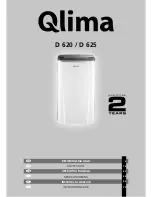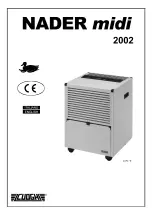
Dorai W - Dehumidifier
10
User manual
PART 1. SAFETY INFORMATION
4) Ensure that seals or sealing materials have not degraded.
NOTE:
The use of silicon sealant may inhibit the effectiveness of some types of leak detection equipment.
8. Repair to intrinsically safe components
Do not apply any permanent inductive or capacitance loads to the circuit without ensuring that this will not
exceed the permissible voltage and current permitted for the equipment in use. Intrinsically safe components
are the only types that can be worked on while live in the presence of a flammable atmosphere. Replace
components only with parts specified by the manufacturer. Other parts may result in the ignition of refrigerant in
the atmosphere from a leak.
9. Cabling
Check that cabling will not be subject to wear, corrosion, excessive pressure, vibration, sharp edges or any
other adverse environmental effects. The check shall also take into account the effects of aging or continual
vibration from sources such as compressors or fans.
10. Detection of flammable refrigerants
Under no circumstances shall potential sources of ignition be used in the searching for or detection of
refrigerant leaks. A halide torch (or any other detector using a naked flame) shall not be used.
11. Leak detection methods
Electronic leak detectors shall be used to detect flammable refrigerants, but the sensitivity may not be
adequate, or may need re-calibration. (Detection equipment shall be calibrated in a refrigerant-free area.)
Ensure that the detector is not a potential source of ignition and is suitable for the refrigerant used. Leak
detection fluids are suitable for use with most refrigerants but the use of detergents containing chlorine
shall be avoided as the chlorine may react with the refrigerant and corrode the copper pipe-work. If a leak
is suspected, all naked flames shall be removed/ extinguished. If a leakage of refrigerant is found which
requires brazing, all of the refrigerant shall be recovered from the system, or isolated (by means of shut off
valves) in a part of the system remote from the leak.
12. Removal and evacuation
The following procedure shall be adhered to:
• Remove refrigerant;
• Purge the circuit with inert gas;
• Evacuate;
• Purge again with inert gas;
• Open the circuit by cutting or brazing.
The refrigerant charge shall be recovered into the correct recovery cylinders. The system shall be flushed
with OFN to render the unit safe. This process may need to be repeated several times. Compressed air or
oxygen shall not be used for this task.
Ensure that the outlet for the vacuum pump is not close to any ignition sources and there is ventilation
available.
13. Charging procedures
• Ensure that contamination of different refrigerants does not occur when using charging equipment.
• Hoses or lines shall be as short as possible to minimise the amount of refrigerant contained in them.
• Cylinders shall be kept upright.
• Ensure that the refrigeration system is earthed prior to charging the system with refrigerant.
• Label the system when charging is complete (if not already).
• Extreme care shall be taken not to overfill the refrigeration system.
• Prior to recharging the system it shall be pressure tested with OFN.
• The system shall be leak tested on completion of charging but prior to commissioning. A follow up leak
Summary of Contents for Dorai D10W
Page 1: ...ENG User manual DORAI W Dorai D10W Dorai D12W...
Page 21: ...NOTES...
Page 22: ...NOTES...
Page 23: ...NOTES...










































